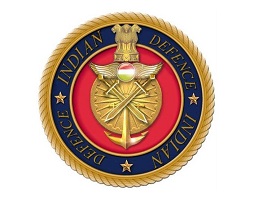1. Eligibility Criteria:
Age criteria:
• For Indian Military Academy (IMA) age limit is between 19 to 24 years
• For Indian Naval Academy (INA) age limit should be between 19 to 22 years
• For Indian Air Force Academy (AFA) age limit should be between 20 to 24 years
• For Officer's Training Academy, the age limit is 19 to 25 years.
Qualification
I. For I.M.A. and Officers' Training Academy, Chennai — Degree of a recognized University or equivalent.
II. For Indian Naval Academy—Degree in Engineering from a recognized University/Institution.
III. For Air Force Academy—Degree of a recognised University (with Physics and Mathematics at 10+2 level) or Bachelor of Engineering.
Final Year Students - Candidates who are studying in the final year/semester Degree course and have yet to pass the final year degree examination can also apply.
Marital Status
• For Indian Military Academy, applicants should be- Unmarried
• For Indian Naval Academy, applicants should be- Unmarried
• For Air Force Academy, applicants should be- Unmarried
• For Officers Training Academy (SSC Men) applicants should be- Unmarried
• For Officers Training Academy (SSC Women Non-Technical courses)- Unmarried or issueless widowed or issueless divorcees who didn't remarry
Physical Standard
Candidates must be physically fit according to physical standards for admission to Combined Defence Services Examination as per guidelines.
A. The candidate must be in good physical and mental health and free from any disease/disability, which is likely to interfere with the efficient performance of duties.
B. There should be no evidence of weak constitution, bodily defects or underweight. The candidate should not be overweight or obese.
C. The minimum acceptable height for male candidates is 157.5 cms. (157 cms for Navy and 162.5 cms for Air Force). For Women candidate’s minimum acceptable height is 152 cms.
Note: For Gorkhas and individuals belonging to hills of the North-eastern region of India, Garhwali and Kumaon, the Minimum acceptable height will be 5 cms less. In the case of candidates from Lakshadweep, the minimum acceptable height can be reduced by 2 cms.
D. The candidates should have a sufficient number of natural and sound teeth. A minimum of 14 dental points will be acceptable. When 32 teeth are present, the total dental points are 22.
Physical Conditioning:
A. Running: 2 to 4 Km. in 15 minutes
B. Skipping
C. Pushups & Sit-ups: Minimum 20 each
D. Chin-ups: Minimum 08
E. Rope Climbing: 3 to 4 metres.
Visual Standard
Visual Standards for Army
| Male | Female |
| Vision
(corrected) better eye 6/6 and worse eye 6/12 | Vision(corrected)
better eye 6/6, worse eye 6/12 |
| Myopia
of not more than minus 3.5 D | Myopia
of not more than minus 5.5 D |
| Manifest
hypermetropia of not more than plus 3.5 D including Astigmatism | Manifest
hypermetropia of not more than plus 3.5 D including Astigmatism. |
Visual Standards for Navy
• Uncorrected without glass - 6/12
• Corrected with glass - 6/6
• Limits of Myopia - 1.5
• Limits of Hypermetropia +1.5
Visual Standards for Indian Air Force
• One must have 6/6 in 1 eye and 6/9 in the other, which can be correctable to 6/6 only for hypermetropia.
• Near Vision must be N-5 for each eye.
2. CDS Exam Pattern for IMA, INA & IAFA :
| Name of the Subject | Total Duration | Number of questions |
| English | 2
hours | 120 |
| General
Knowledge | 2
hours | 120 |
| Elementary
Mathematics | 2
hours | 120 |
CDS Exam Pattern 2021 for OTA:
| Name of the Subject | Total Duration | Number of questions |
| English | 2
hours | 120 |
| General
Knowledge | 2
hours | 120 |
Important Details of the CDS Exam Pattern:
• The exam of CDS will be offline, i.e. through pen and paper mode.
• The question paper of Mathematics and General Knowledge will be set bilingually, i.e. in Hindi as well as English.
• All the tests will consist of objective type questions only.
• English and General Knowledge sections will comprise 120 questions each, while the Mathematics section would contain 100 questions.
• There is a penalty for every wrong answer. 1/3rd marks will be deducted for every incorrect answer marked by the candidate.
• The help of the scribe will not be permitted to write the answers in the exam under any circumstances.
3. CDS Syllabus
Here is the syllabus of the CDS exam for each individual section:
1. English Syllabus for CDS Exam
The aim of this section is to test the understanding of English as well as word usage by the candidates.
Questions in this section will be asked from the following topics :
• Fill in the blanks.
• Reading Comprehension.
• Vocabulary (Synonyms/ Antonyms/ Phrases).
• Sentence Rearrangement (Jumbled sentences).
• Spotting error.
• Sentence improvement/ Correction
2. General Knowledge Syllabus for CDS Exam
This section aims to check how well the candidates keep up with the current events and how well they understand their surroundings, especially in reference to their scientific aspects.
| TOPIC | DESCRIPTION |
| Current
Affairs | Cover
news of important international and national summits/ conferences, awards,
sports-related news, books, and authors etc. |
| Political
Science | Important
facts of the Indian constitution, fundamental rights, and directive principles,
powers of the president and prime minister, constitutional bodies, Indian
judiciary etc. |
| Indian
History | Questions
may be asked from Ancient, Medieval and Modern India. |
| Geography | Prepare important facts of Indian as well as world geography. |
| Economics | Prepare
topics like Budget, Five- year plan, foreign trade etc. |
| General
Science | • In physics, focus on topics like optics, motion, force, units, heat, electricity, temperature etc. • In Chemistry, prepare important topics of organic, inorganic, physical and general chemistry. • In Biology, focus on the topics of important diseases, botany, and zoology as well as human biology. |
| Defence
Related News | Questions
in this section may be asked from important defence related topics like Army
Day, Navy Day, recent developments etc. |
3. Elementary Mathematics Syllabus for CDS Exam
| Topic | Description |
| Arithmetic | • Number System (natural, integers, rational & real numbers) • Fundamental operations (subtraction, addition, division, multiplication) • Unitary method • Percentages • Time & Work • Simple & Compound Interest • Time & distance • Ratio & proportion • Profit & loss • Elementary number theory • Composite & prime numbers • Divisibility tests • Theorem of factorisation • Factors & Multiples • Euclidean algorithm • Laws of algorithm & algorithmic tables |
| Algebra | • Basic operations • Remainder theorem • L.C.M. & H.C.F. • Polynomial theories • Quadratic equations(relation between roots & its coefficients) • Linear equations in 2 variables • Set language and set notation • Laws of indices • Conditional identities • Rational Expressions |
| Trigonometry | • All about Sine a, Cos a, Tan a when 0⁰, 30⁰, 45⁰, 60⁰ and 90⁰ • Simple trigonometric identities • Trigonometric tables • Heights and distance |
| Geometry | • Plane & plane figures • Lines, and angles • Important theorems (like angle property based) • Parallel lines • Congruency of triangles • Medians & Altitudes • Similar triangles • Parallelogram • Circles • Rectangle • Square |
| Mensuration | • Areas of circles • Triangles • Rectangles • Squares • Parallelograms • Volume • Surface area of cuboids • Cones • Cylinders • Spheres. |
| Statistics | • Tabulation of statistical data • Graphical representation of frequency polygons • Bar graphs • Histograms • Pie charts • Measures of central tendency |





Contrary to popular belief, Lorem Ipsum is not simply random text. It has roots in a piece of classical Latin literature College in Virginia ?
It is a long established fact that a reader will be distracted by the readable content of a page when looking at its layout. The point of using Lorem Ipsum.